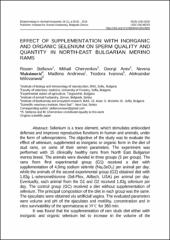Effect of supplementation with inorganic and organic selenium on sperm quality and quantity in north-east bulgarian merino rams

View/
Date
2018Author
Stefanov, Rossen
Chervenkov, Mihail
Anev, Georgi
Maksimović, Nevena
Andreeva, Madlena
Ivanova, Teodora
Milovanović, Aleksandar
Metadata
Show full item recordAbstract
Selenium is a trace element, which stimulates antioxidant defenses and improves reproductive functions in human and animals, under the form of selenoproteins. The objective of the study was to evaluate the effect of selenium, supplemeted as inorganic or organic form in the diet of stud rams, on some of their semen parameters. The experiment was performed with 15 clinically healthy rams from North East Bulgarian merino breed. The animals were divided in three groups (5 per group). The rams from first experimental group (G1) received a diet with supplementation of 4,0mg sodium selenite (Na2SeO3) per animal per day, while the animals of the second experimental group (G2) obtained diet with 1.83g L-selenomethionine (Sel-Plex, Alltech, USA) per animal per day. Eventually, each animal from the G1 and G2 received 1.83g selenium per day. The control group (GC) received a diet without supplementation of selenium. The principal composition of the diet in each group was the same. The ejaculates were obtained via artificial vagina. The evaluated parameters were volume and pH of the ejaculates and motility, concentration and in vitro survivability of the spermatozoa at 39˚С for 360 min.
It was found that the supplementation of ram studs diet either with inorganic and organic selenium led to increase in the volume of the ejaculates, motility and survivability of the spermatozoa. The pH of the freshly obtained semen was not affected by selenium treatment.
